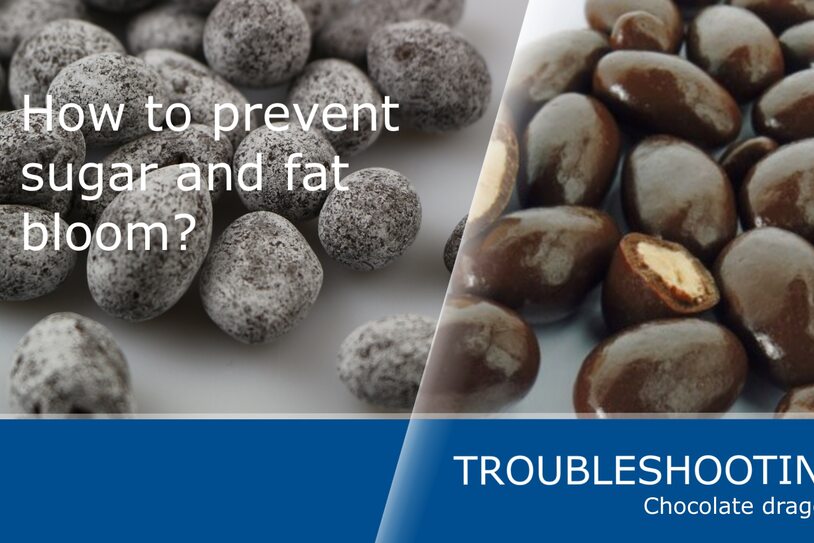Chocolate dragées with a fat or sugar bloom show undesired white spots or even white layers on their surfaces. Though they look similar in appearance, the root cause for each issue is different. CAPOL® Application Technology specialists can inform you on how to avoid blooms of either kind.

Have you ever seen chocolate with white spots or a white, film-like, layer covering a piece of chocolate? Many consumers have probably experienced this phenomenon more than once, as it can be a common issue in chocolate production. A significant number of these consumers will intuitively associate the unappetizing look with an expiration of shelf life, perhaps spoilage or mold. While none of these are the reason causing the whitish layer, there is no doubt that a perfect candy finish acts as a quality signal to consumers. This is especially true for chocolate dragées, which come in various shapes, with a multitude of possible inclusions and often are characterized by a beautifully glossy and shining surface.
“Fat bloom is a very common problem in the chocolate industry”, says Javier Miles, Technical Sales Manager at CAPOL. “It can appear in any kind of chocolate product, including dragées.” Javier is a Food Engineer specialized in chocolate and confectionery applications, and is very familiar with the difficulties posed when working with chocolate. “Fat bloom, as the name indicates, is nothing but fat or oil that has migrated to the surface and crystalized again”, he explains. The fat crystals create a whitish or pale colored layer. At least two different reasons can cause a migration of the oil or fat. Javier introduces the concept of tempered chocolate in the course of this discussion: “Cocoa butter, which is one of the ingredients in what we call ‘real chocolate’, has the ability to crystalize in more than one configuration. Each of them have a different melting point.” During the tempering, it is the intention to let the cocoa butter crystalize in one particular way that will provide desirable characteristics for chocolate. Javier explains the issue arising from improper tempering: “If this process is not done correctly, an uncontrolled crystallization will take place. The low melting point crystals will melt and migrate to the surface creating the fat bloom effect.” In avoidance of this effect, he recommends paying attention to the process air and the surface temperature in order to find the right balance that will support the tempering process.
Specific to the manufacturing of chocolate dragées, there tends to be another primary driver to fat bloom. Chocolate-coated nuts or any other type of center, which contains oils or fat inside, can contribute to fat bloom if no preventive measures are taken. “Nuts contain a high amount of oils that have a low density and viscosity. This oil will eventually start migrating from the center of the nut to the outside chocolate, finding its way out on to the surface”, says Javier. During this process, the oil affects the crystallization of the cocoa butter and drags part of it as well. Once the oil or fat mix reaches the surface, a new crystallization takes place, creating the fat bloom layer. To overcome this problem, Javier recommends his customers to use a pre-coating agent that will seal the nuts and stop the oils from migrating through it: “Our FIX GUM® range can take care of this problem, ensuring a ‘bulletproof’ shell that will prevent these oils from reaching the exterior surface.”
Sugar bloom can sometimes be confused with fat bloom, due to the similarities in appearance on the surface of chocolate dragées, but this is the only thing they have in common. A superficial crystallization of sugar in chocolate products is the cause of this effect. “The phenomenon is linked to a sudden change in the temperature of the chocolate surface”, says Javier. “The thermal shock creates a fast condensation in a high humidity production environment that will re-dissolve the sugar contained within the chocolate formulation.” The sugar flows on to the surface and once the water has evaporated, crystalizes once again, creating a white to grayish film on the dragée’s surface – where one would expect a nice glossy and shinning surface. Javier knows a remedy: “In order to avoid this problem it is important that the temperature between production, storage and packaging is not subject to high fluctuations. I also recommend manufacturers to not surpass a maximum threshold of relative ambient humidity in their production area.”
Have you encountered a fat or sugar bloom in the manufacturing of your chocolate dragées? Our CAPOL® Application Technology team shares a passion for perfect candy finishes, we are happy to offer our expertise alongside our high quality ingredients.